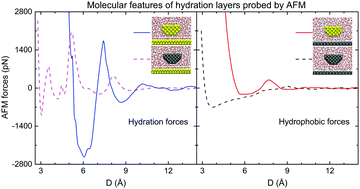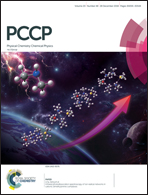Molecular features of hydration layers probed by atomic force microscopy
Abstract
Structurally-ordered layers of water are universally formed on a solid surface in aqueous solution or under ambient conditions. Although such hydration layers are commonly probed via atomic force microscopy (AFM), the current understanding on how the hydration layers manifest themselves in an AFM experiment is far from complete. By using molecular dynamics simulation, we investigate the hydration layers on a hydrophilic or hydrophobic surface probed by a nanoscale tip. We study the density and molecular orientation of water, the free energy, and the force on the tip by varying the tip–surface distance. The force–distance curve oscillates due to the transition between the mono-, bi-, and tri-layers of water confined between the tip and the surface. If both the tip and the surface are hydrophobic, water confined between the tip and the surface evaporates due to the dewetting transition, giving a hydrophobic force without oscillation. The periodicity of oscillation in the force differs from the structural periodicity of water. With a close proximity of the tip, the molecular dipoles align parallel to the surface, regardless of whether the tip and the surface are hydrophilic or hydrophobic.



 Please wait while we load your content...
Please wait while we load your content...